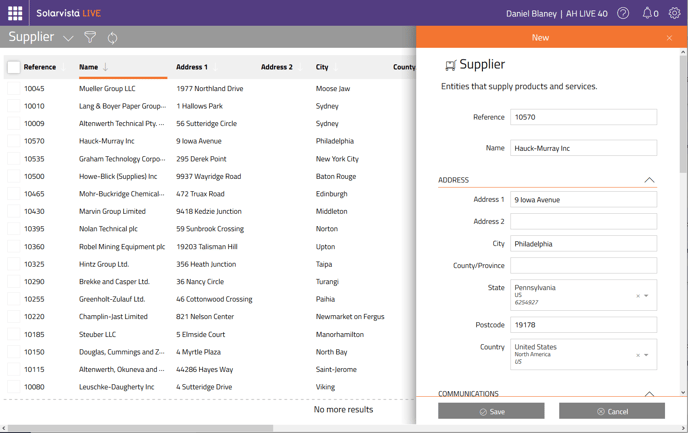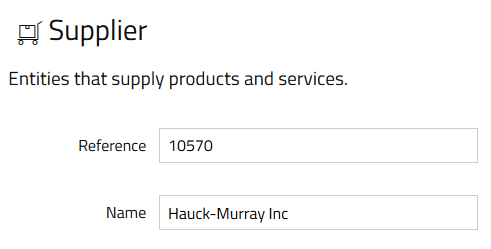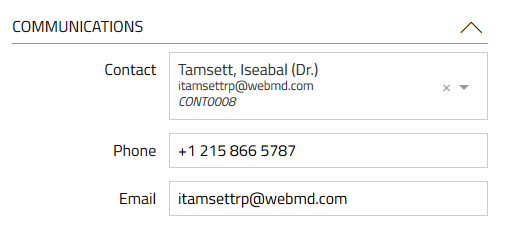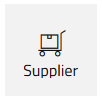Suppliers
A detailed look at the fields and dependencies in the Supplier records, how to create a new Supplier record & editing existing Supplier records.
![]()
The “Suppliers” record holds information about the entities that you use as Suppliers.
Some features are dependent upon your select plan for your account.
Indicates a feature is only available in Standard or above.
Indicates a feature is only available in Enterprise.

It holds their name, address and contact information. At the time of writing, this file is only used for reference within the Product file, to assist users with re-ordering parts and materials. It is not essential to populate this file.
Where Supplier Records are Used
The following files refer to Supplier records so if you plan to use any of these, setting up the records in this file will be important or even critical:
Data Sources:
- Products
Pre-requisite Files for Supplier Records
When setting up Supplier records, it is recommended to review the other data files that may need to be referred to by each record. These are the files that you may need to setup in advance:
- Currencies
- Users
- Categories (Suppliers)
- Sectors [via Categories]
- Contacts
Field Descriptions for Supplier
The ID section holds the unique ID and names for the supplier:

Reference - holds the unique ID for the record (most records in Solarvista have one of these). It cannot contain any spaces or non-standard characters. Once the record is saved, it is not possible to edit it afterwards. In most default situations, the Reference is automatically set using a counter sequence, however, you can setup your own if you prefer.
Name - the formal name of the supplier/vendor e.g. ABC Systems Limited, XYZ Metals Inc. etc.
The Address section holds the physical address of the Supplier:

Address 1 – first line of address.
Address 2 – optional second line of address (not including city or town name).
City – name of town or city.
County/Province – name of county or province. This is dependent upon State field selection (which in turn is dependent upon Country selection).
Postcode – the postal code or zip code of the supplier.
State – name of state (if applicable). This is dependent upon Country field selection.
Country – name of country. This field defaults to the setting in Account Settings and must be selected from the in-built list of countries.
The Communications section holds the preferred contact and the supplier’s phone/email:

Contact – allows selection of a preferred/primary contact from the Contacts file. Alternatively, it allows a free text name to be typed into the field.
Phone – will automatically populate with the phone information from a selected contact. It is also possible to enter a phone number directly.
Email – will automatically populate with the email address information from a selected contact. It is also possible to enter an email address directly.
The Financial section holds financial information about the supplier.
This is used in the billing process ![]() , however these fields are still available in LIVE Lite
, however these fields are still available in LIVE Lite ![]() for reference only:
for reference only:

Currency – holds the Currency that purchases are made in. This field is itself defaulted from the setting in Account Settings. Currencies are pre-populated in Solarvista for most countries’ currencies, but these should be edited to ensure the rates and codes are correct before use.
Time Zone – holds the Time Zone of the Supplier's location. This is defaulted when the State is populated.
Buyer – holds the internal User that is responsible for the supplier.
The Other section holds miscellaneous additional information:

Memo – a free text field that can be used for any purpose.
Code – used to hold an optional alternative ID code. This may be applicable in situations where information is being transferred to other systems via Connectors and the code here is used to identify the record to the other system.
Sector – a high-level selection of industry sector and is pre-populated with choices from the Categories file. Selection of a Sector applies filters the next field, Industry.
Industry – a more detailed, lower level classification of industry taken from the Industries file. These are pre-populated with a ready-made set of classifications however, the previous field, Sector, must be selected first.
Category – a category for the customer e.g. ‘Primary”, “Secondary”, “Grade A” etc. These are defined in the Categories file and set with a Type= “Supplier”.
Status – defines whether the record is in use or not. Initially, records are set to a status of “Draft”. Only “Active” status records are available for selection within the Solarvista system.
Creating a New Supplier Record
To create a new Supplier record:
- Click on the “Plus” button.

A menu will appear. - Within the “Data Sources” section, find “Supplier”.

- Click on “Supplier”.
- A new “empty” Supplier record will appear.
- Populate all fields as you require.

- Click on the “Save” button. You may need to refresh the page to see the new record in a view.

Editing a Supplier Record
To edit a Supplier record:
- From the main menu, select Suppliers.

The default view for Suppliers will open. - Click on the Quick Filter button.

- Enter criteria for the Supplier record you are looking for and click Apply button.

- The view will update. Find the record you are wanting to edit.
- Click anywhere on the row that shows the record. The record will open.
- You can edit any field that allows editing (some could be set to read only).
- Click on “Save” button to save changes.

Deleting a Supplier Record
To delete a Supplier record.
- From the main menu, select Supplier. The default view for Suppliers will open.
- Click on the Quick Filter button.

- Enter criteria for the Supplier record you are looking for and click Apply button.

- The view will update. Find the record you are wanting to delete.
- On the left side of the view is a column containing checkboxes.
- Check the box of the record you want to delete.

- Click the “Delete” button on the top right. A slide in dialog will appear prompting you to confirm the delete, by typing in the word “DELETE” again.
- To confirm, click the “Delete” button and the record (or records will be deleted).

Note: You cannot delete a Supplier record that is already in use with a Work Item i.e. Jobs. You can delete Site records referred to only by other Data Sources however this will leave those records without an associated to a valid Customer record. If this happens by accident, you can manually recreate the record ensuring the Reference is identical. You can also change the status of the record to prevent it appearing on screen in future whilst maintaining historical integrity.
Customising or Adding New Fields
Solarvista™ is built upon a uniquely flexible platform that allows you to edit fields (or remove them in some cases) as well as add your own fields. These new fields (or edited characteristics of existing fields) automatically become available within the web portal and the mobile apps. For more information, refer to the Customising section.
Importing Supplier Data in Bulk using Import Tool
If you have a lot of supplier information to enter, you may prefer to upload this using the Import Tool that’s built into Solarvista. The Import Tool enables Supplier records to be created from “CSV” text files. CSV files can be created from a wide range of popular applications including Microsoft Excel. For more information on importing data into Solarvista, please refer to the article here.